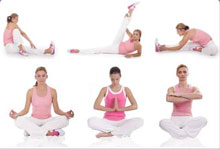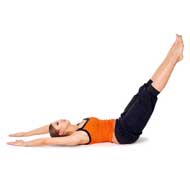- Mountain Pose
- Five pointed star pose
- Cresent Moon Pose
- Chair pose
- Warrior I Pose
- Warrior II Pose
- Side Angle Pose
- Triangle Pose
- High Lunge
- Revolved Side Angle Pose - Parivrtta Parsvakonasana
- Wide-Legged Forward Bend - Prasarita Padottanasana
- Lord of the Dance Pose
- Garland Pose
- Standing Split
- Revolved Triangle Pose
- Extended Triangle Pose
- Low Lunge
- Upward Forward Fold
- Big Toe Pose
- Extended Side Angle Pose
- Dolphin Pose
- Standing Forward Bend
Goddess Pose - Victory Squat
Yoga has become an extremely popular way of life today. Yoga has taken the place of many forms of exercise as a means of relaxing both the body and the mind.
It is estimated that 16 million Americans practice yoga and that another 9 million are more than willing to give this method of workout a shot.
Yoga practices for exercise include what is known as asanas (poses). In this particular article, we will discuss a particular pose called Goddess Pose yoga.
The Goddess Pose is the English name for the ancient yoga pose called Supta Baddha Konasana. The Sanskrit name translates as The Reclined Bound Angle Pose. Below are the meanings of the words that make up the name of the pose.
Supta - reclined; Baddha - bound; and Konasana – angle pose
This pose is a part of Hatha yoga; however, nowadays, it is a part of what is known as Iyengar yoga. Iyengar yoga is a type of yoga where classic yoga poses are made a lot more user friendly, using props such as blocks, straps, blankets and other supports. The reason for the variation is that yoga can be available to a larger section of the crowd.
The Goddess Pose is often mistaken for the Victory Goddess Pose. Described below in a nutshell is the Victory Goddess Pose, after which the Goddess Pose will be explained in detail.
Victory Goddess Pose (Utkata Konasana)
The Victory Goddess Pose is also known as the victory squat. The Sanskrit name for this pose is Utkata Konasana, which literally translates to ‘fierce angle pose’. In this pose, you squat as if you are sitting on a chair, with your legs three inches apart and your heels turned in. Your hands are placed on either side of your face, with the fingers splayed out. The following need to be kept in mind when practicing Victory Goddess Pose:
- When squatting, the knees need to be held back
- The hips need to be thrust forward
- The shoulders should drop down and be withdrawn
- The chest should be projected forward
- When holding the hands on the sides of your head, it is a good idea to pretend that you are holding one of those huge jumping balls over your head.
- It is important to hold your head high and keep your chin parallel to the floor
Benefits of the Victory Squat
- To the Chest (heart and lungs) - Enhances cardiovascular as well as respiratory mechanisms
- To the Hips (kidneys) - This yoga asana stimulates the urinary and reproductive systems
- To the Lower body - The goddess pose strengthens as well as tones the lower body
- Energises the body
Steps
The Goddess Pose unlike the Victory Goddess Pose is a yoga pose to be performed while lying down. Following are the goddess pose steps.
- Sit with your feet splayed out in front of you and your shoulders aligned with your hips (Staff Pose or Dandasana).
- Bend forward and bring the soles of your feet together, with your knees pressed outwards. (Cobbler’s pose or Baddha Konasana).
- Keep the soles of your feet firmly together.
- From the Cobbler’s Pose, lean backwards and lie down on the floor, with the elbows on the floor.
- Exhale, contracting the abdominal muscles and keep the lower back pressed firmly down. This helps to stretch out the muscles of the lower back.
- Then, exhale once again and stretch out your thigh muscles.
- Stay in this pose between 30 seconds to a minute, until you are comfortable.
- Next, lift your knees up together using your hands, and circle around in one direction. This will help strengthen your hip muscles.
- To get up from this pose, roll over to your side and sit up, using your hands.
Precautions
Listed below are some of the precautions you need to take for the Goddess Pose.
Do not attempt to perform this pose if you have the following conditions:
- Shoulder problems
- Hip injury
- Have recently given birth
Other goddess pose - precautions include:
- Use a support under your thighs, if you suffer from a groin or knee injury.
- If you experience cramps or any other problem while practicing this exercise during pregnancy, it is best to consult with your doctor before continuing this yoga pose.
Beginner's Tips
- Exhale after performing each step. This is because exhaling contracts the abdominal muscles, toning, and strengthening them in the process.
- Also, while performing one of the initial poses, the Cobbler Pose, the tightening in the thighs can be relieved by gently rocking the body gently, back and forth.
- Placing a support under each knee can help make this pose easier in the beginning.
- Additionally, placing support such as bolsters, blocks, and folded blankets to support your spine while reclining, may be helpful for beginners.
- Beginners can also use a yoga strap to maintain the legs in a folded position, while reclining back.
- It is also a good idea not to press your knees to the floor in order to stretch them. Positioning your knees lightly will help you stretch them better.
Benefits to the body
This particular yoga pose benefits most of the organs in the abdomen such as the:
- Ovaries
- Prostate gland
- Kidneys
- Bladder
The pose is also known to relax the muscles of the knees, the thighs and the groin.
Therapeutic applications
As this particular yoga pose is great for abdominal organs, pelvis, knee and thigh muscles, it is used as therapy for a lot of medical conditions. Listed below are some of the therapeutic applications of the Goddess Pose.
- Increases circulation
- Stimulates cardiovascular activity
- Relieves stress
- Relieves menstrual pain
- Helps with menopausal pain
- Helps against depression
- Helps stretch out the pelvic muscles, which is why it is recommended for pregnant women.
Variations
Listed below are some of the variations for Goddess Pose.
- Elevating your feet if you experience tension in your thigh muscles makes this an easier exercise. You can do this by placing a block or a blanket under your feet.
- For beginners, this asana may cause a strain on the neck and head. To prevent the strain, you can always use a pillow until you are more comfortable with the pose.
Preparatory Poses
Preparatory poses for the Goddess Pose include:
- Reclining Big Toe Pose - Supta Padangusthasana
- Hero Pose - Virasana
- Tree Pose - Vrksasana
Follow up poses
Follow up poses for the Goddess Pose include:
- Standing poses
- Seated twisting poses
- Forward bend poses
 Find Pose
Find Pose

